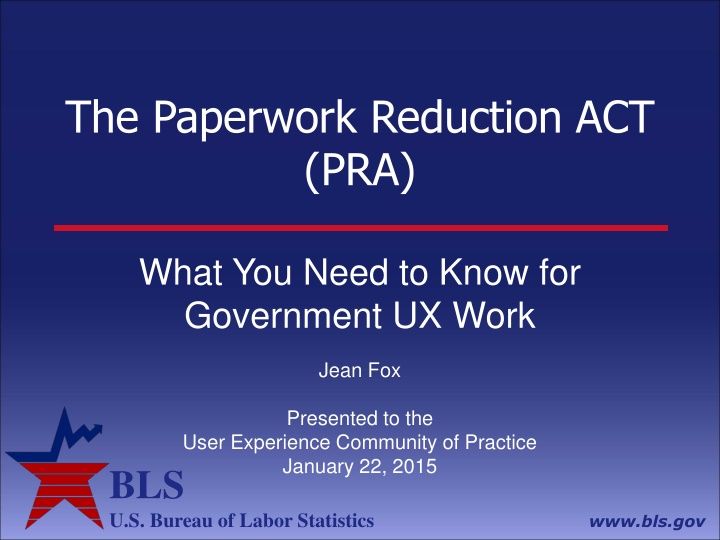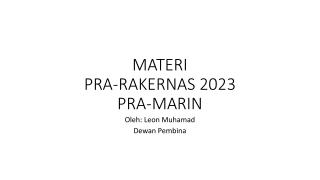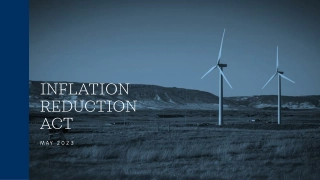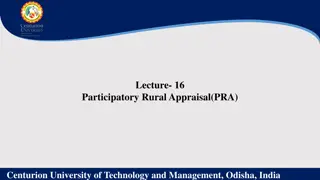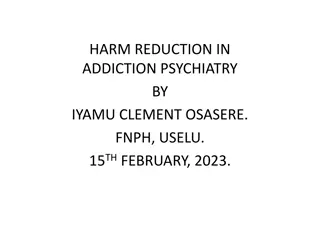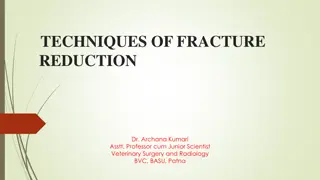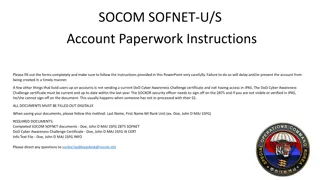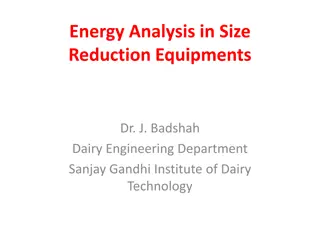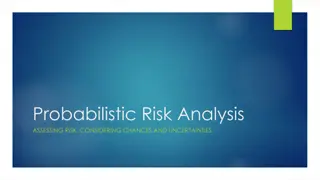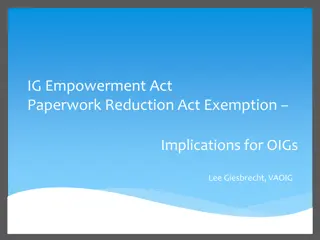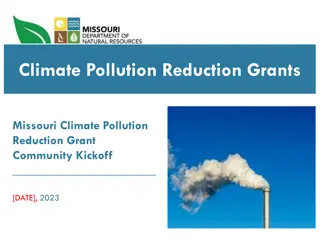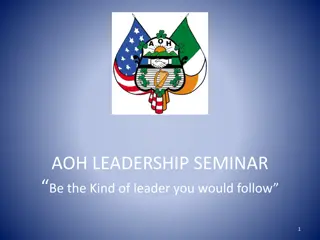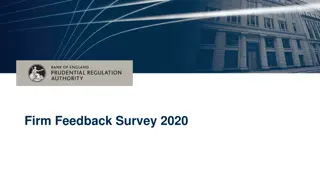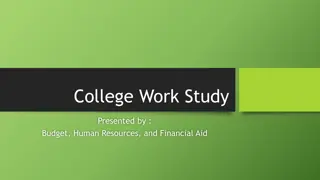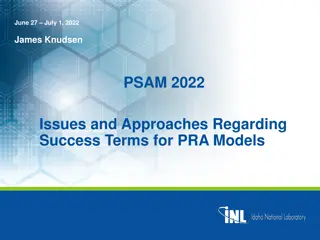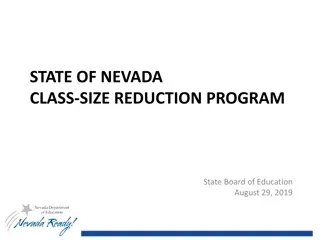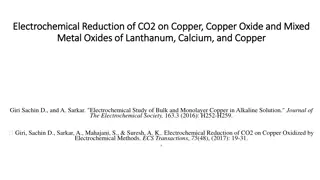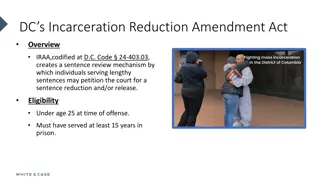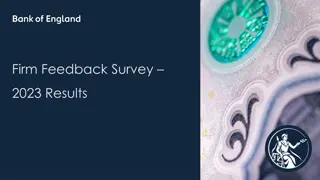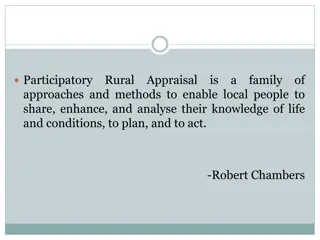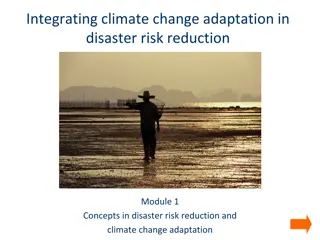The Paperwork Reduction Act (PRA) Essentials for Government UX
Learn about the Paperwork Reduction Act (PRA), its application to data collection in government agencies, and the key definitions and processes involved. Understand how PRA aims to protect the public from unnecessary burden and maximize the utility of collected information. Discover when PRA applies, exemptions, and how to navigate the clearance process effectively.
Download Presentation

Please find below an Image/Link to download the presentation.
The content on the website is provided AS IS for your information and personal use only. It may not be sold, licensed, or shared on other websites without obtaining consent from the author.If you encounter any issues during the download, it is possible that the publisher has removed the file from their server.
You are allowed to download the files provided on this website for personal or commercial use, subject to the condition that they are used lawfully. All files are the property of their respective owners.
The content on the website is provided AS IS for your information and personal use only. It may not be sold, licensed, or shared on other websites without obtaining consent from the author.
E N D
Presentation Transcript
The Paperwork Reduction ACT (PRA) What You Need to Know for Government UX Work Jean Fox Presented to the User Experience Community of Practice January 22, 2015 BLS U.S. Bureau of Labor Statistics www.bls.gov
Introduction BLS collects lots of data Our Clearance Officers know the process I got feedback from our Clearance Officers and OMB But I don t know everything about the process Every agency may be different BLS www.bls.gov 2
Overview PRA Basics Types of PRA, and the process for each Traditional Generic Fast Track BLS www.bls.gov 3
Goal Give you enough information to get through most of the process You can do it! BLS www.bls.gov 4
PRA Basics The Paperwork Reduction Act (PRA) requires federal agencies to submit proposed collections of information for review and approval by the Office of Management and Budget (OMB) When collecting the same data from more than 9 people (including contractors, but not federal employees) over 12 months. Purpose is to Protect the public from inappropriate data collection and unnecessary burden Maximize the practical utility of information collected BLS www.bls.gov
When does PRA Apply? PRA Applies To all kinds of data collection From income tax forms to regulatory information, to user experience and other research efforts. Regardless of the type of data Personally Identifiable Information (PII), other sensitive data, or any other data To the TOTAL sample size Across all evaluation efforts run over 12 months (you can t just run separate, smaller, slightly- different studies) BLS www.bls.gov 6
When does PRA Apply? PRA may not apply: A recent OMB memo has exempted from the PRA or clarified PRA applicability for social media and web 2.0 uses. BLS www.bls.gov 7
PRA Definitions Clearance Officer The person at your agency who handles OMB submissions To find your Clearance Officer, start with your CIO. OMB Desk Officer The person at OMB who reviews your submission BLS www.bls.gov 8
PRA Definitions Office of Information and Regulatory Affairs (OIRA) The group at OMB responsible for reviewing submissions Burden hours The total amount of time needed for participants in a study (including recruiting and screening) (Hours per participant) * (number of participants) BLS www.bls.gov 9
PRA Definitions Information Collection Request (ICRs) The materials you submit to OMB to get your data collection approved. Also called a PRA Submission or OMB Clearance Package Includes the sampling method, protocol, any materials, etc. BLS www.bls.gov 10
PRA Definitions ICRs are publicly available at Reginfo.gov FYI The OMB Control number for UX work at BLS is 1220-0141. BLS www.bls.gov 11
PRA Definitions Federal Register notice Allows the public to review and comment Submission includes the ICR plus a summary. BLS www.bls.gov 12
Types of OMB Clearance Traditional For large data collection efforts Generic Sometimes called umbrella clearance For a variety of studies, quantitative analysis, and publishing Fast Track for Service Delivery Feedback For quick qualitative studies Customer Satisfaction Just a type of Generic Clearance BLS www.bls.gov 13
Traditional Process Step 1. Develop a plan for data collection. Step 2. Submit a 60-day notice to the Federal Register Must include the protocol for data collection Step 3. Receive and address public comments BLS www.bls.gov 14
Traditional Process Step 4. Submit for Department Review Step 5a. Submit a30-day notice to the Federal Register Same as 60-day notice, with changes as appropriate Step 5b. Submit ICR to OMB Step 6. OMB reviews submission BLS www.bls.gov 15
Traditional Process Develop Study Plan May take weeks, months, or years, depending on the project. Includes writing ICR and FR material FR 60-day notice Includes FR notice plus supporting statements Revision and Department Review Departmental review time may be unpredictable FR 30-day notice OMB Review of ICR Note the unpredictable time in developing the study plan, departmental review, and OMB review
Traditional Process Approval renewed every 3 years. Note that FR notices and ICRs are publicly available and may need agency approval. BLS www.bls.gov 17
Traditional Process Appropriate for very large data collection efforts Some government surveys collect data from hundreds of thousands of respondents or more Small, short user experience studies may be able to use the generic process BLS www.bls.gov 18
Generic Clearance Covers studies that are voluntary, low- burden, and uncontroversial Studies with vulnerable participants or risky methods may not be eligible. BLS www.bls.gov 19
Generic Clearance Process is basically the same. An agency: Submits 60-day FR notice (Sample BLS notice) Revises notice and gets departmental approval Submits a 30-day FR notice and an ICR to OMB Template for OMB submission Gets OMB approval for Generic Clearance BLS www.bls.gov 20
Generic Clearance Additional Step: Agency submits separate proposal for each study Review is typically an expedited process based on an agreement with OMB during clearance approval Depends on the nature of the research. For BLS, it is typically 2-4 weeks. Approval renewed every 3 years. BLS www.bls.gov 21
Generic Clearance Federal Register notices and the ICR address information such as Types of studies done Methods used Environments in which studies are done Maximum burden hours to be used Consent form BLS www.bls.gov 22
Generic Clearance ICs (Information Collection) are basically, a proposal for the effort. They include Goals Protocol Participants Data to be collected Analysis plan Burden hours, etc. BLS www.bls.gov 23
Fast Track Process Another option for UX work Applies when The data collection is focused on improving existing or future services, products, or communication materials The data collection is voluntary Statistical rigor is not required The burden on participants is not high, AND Public dissemination of results is not intended BLS www.bls.gov 24
Fast Track Process Methods covered: Usability tests Focus groups Customer satisfaction qualitative surveys Online surveys Comment cards or complaint forms Other similar methods BLS www.bls.gov 25
Fast Track Process Follows the same basic steps OMB submitted the 60-day notice to the FR on behalf of many agencies Each agency submitted their own 30- day FR notice and ICR. BLS www.bls.gov 26
Fast Track Process The agency then submits each study to OMB for approval. Submission form OMB replies within 5 business days. BLS www.bls.gov 27
Fast Track Process OMB Submitted the 60-day notice on Dec 22, 2010 Agencies / Departments then submitted their own 30-day notice To find out if your agency is eligible, check with your Clearance Officer Agencies included in the 60-day notice are in the Fast Track FAQ document. Agencies not listed have to complete the entire clearance process independently. BLS www.bls.gov 28
Fast Track Process Most original Fast Track Clearances have expired Check on reginfo.gov or with your Clearance Officer To renew, agencies must do the whole process on their own. BLS www.bls.gov 29
Other Notes Benefits of Generic over Fast Track With the Generic approval, you can publish results The generic process covers a wider range of work (e.g., studies purely for research) You can use more rigorous statistical analyses with the generic process Compensation for participants Statistical agencies can pay $40, per OMB. Other agencies seem able to pay more. BLS www.bls.gov 30
Data Confidentiality Follow laws/regulations for storing, managing, and protecting data for your agency Also follow ethical guidelines about what data you store (see the UXPA and HFES codes of ethics) In the informed consent, state how you will handle all their data, including video Don t use data in any other way without the participant s written consent BLS www.bls.gov 31
References From OMB: Paperwork Reduction Act of 1995 PRA Primer (Overview of the PRA), 2010 Memo on Generic Clearances, 2010 Fast Track Memo, 2011 Fast Track FAQs Guidance from OMB on surveys for statistical purposes, 2006 Social Media and the PRA Template for OMB submission for generic clearance package From Digitalgov.gov: Blog on Fast Track Process Regulations about data collection 5 CFR Part 1320 BLS www.bls.gov 32
Questions? Jean E. Fox Fox.Jean@BLS.gov BLS www.bls.gov 33
